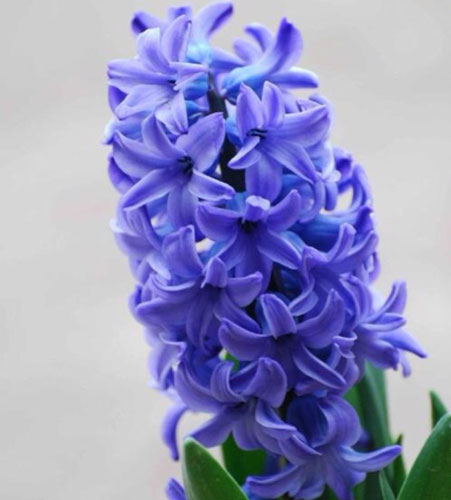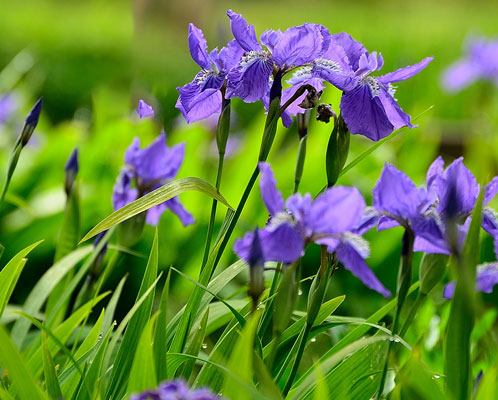Scaevola Aemula: Grow & Care for Fairy Fan Flower
Written by Iris
Aug 02 2021

Scaevola Aemula (fairy fan flower) is generally arranged as a ground cover plant on the roadside of the courtyard. The flowers of Scaevola Aemula (fairy fan flower) are particularly elegant and charming, and the flower types are also special. The flowers are in the shape of a small fan, and the flower color is usually lavender or light blue. color.

Steps for Scaevola Aemula (fairy fan flower) Propagation with Stem Cuttings
Not only is fairy fanflower attractive and tolerant of adverse conditions, cuttings take root easily so you can inexpensively produce your own attractive low-maintenance ground cover.
Different plants have different water needs. Some plants prefer staying on the dry side, others like to be consistently moist. Refer to the plant label to check a plant's specific requirements.
Ideally water should only be applied to the root zone - an area roughly 6-12” (15-30cm) from the base of the plant, not the entire plant. A soaker hose is a great investment for keeping plants healthy and reducing water lost through evaporation. Hand watering using a watering wand with a sprinkler head attached is also a good way to control watering. If the garden area is large, and a sprinkler is necessary, try to water in the morning so that plant foliage has time to dry through the day. Moist foliage encourages disease and mold that can weaken or damage plants.
To check for soil moisture use your finger or a small trowel to dig in and examine the soil. If the first 2-4” (5-10cm) of soil is dry, it is time to water.
Remove old flowers to keep plant looking healthy and prevent seed production that drains the plant’s energy at the expense of forming new flowers.
Some plants are grown only for their attractive foliage (such as coleus, dusty miller and flowering kale). Their flowers are not very showy and any buds should be pinched off to keep the foliage looking its best.
How to Choose and Prepare a Planting SiteHow to Grow Scaevola Aemula (fairy fan flower)How to Care for Scaevola Aemula (fairy fan flower)Varieties of Scaevola Aemula (fairy fan flower)Scaevola Aemula (fairy fan flower) FAQ
How to Choose and Prepare a Planting Site
Plant scaevola Aemula (fairy fan flower) in a location that receives at least 6 to 8 hours of sunlight daily in well-drained garden soil. scaevola aemula (fairy fan flower) aren't particular about soil type or pH, but they won't tolerate soggy conditions. Because Scaevola Aemula (fairy fan flower) are drought-tolerant, they are a good choice for low-water gardens. They also do well in coastal gardens because they aren't bothered by salty air.
How to Grow Scaevola Aemula (fairy fan flower)
Steps for Scaevola Aemula (fairy fan flower) Propagation with Seeds
The seed of most of hybrids is sterile and, therefore, not suitable for starting new plants. Even those that do produce viable seed are protected by royalty rights and must be propagated asexually.Steps for Scaevola Aemula (fairy fan flower) Propagation with Stem Cuttings
Not only is fairy fanflower attractive and tolerant of adverse conditions, cuttings take root easily so you can inexpensively produce your own attractive low-maintenance ground cover.
- Make a cut at a 45-degree angle just below a leaf node with a clean, sharp knife. Select healthy 4- to 6-inch stems from this season’s growth that have had some time to mature. Use the knife to cut away any leaves from bottom half of the cutting. Dip the end in rooting hormone, enough to cover the bottom node. Tap off any excess powder.
- Fill a pot with well-draining potting soil or a mixture of peat moss and perlite. Push a pencil into the rooting medium to make a hole for the cutting; if you push the stem directly into the soil, you risk brushing off the rooting powder or damaging the stem. Position the bottom node below the soil’s surface and gently pack soil around it. Place the stems a few inches apart so you can fit several cuttings in the pot. Water the cuttings well.
- Place the pot in a sunny area outdoors. Keep the soil evenly moist but not soggy; overwatering will cause the stems to rot.
- Check your cuttings weekly to see if they have taken root, beginning one month after you have planted them. Gently tug on one of the plants; if you feel resistance, roots have formed. Avoid tugging on your cuttings more often than once a week as new roots are delicate and can break off easily. New leafy growth is a good sign that roots have formed. Allow the plants to develop several roots that are at least 1 to 2 inches long before you transplant them. Gently transplant to a sunny location, placing the plants three feet apart. Water them in well and fertilize.

How to Care for Scaevola Aemula (fairy fan flower)
Light
Choose a site with full to partial sun for best scaevola performance. Plants in hot, dry desert areas may remain more pert when placed in a location with dappled shade.Soil
Rich soil isn't necessary for thriving scaevola plants. While soil of average fertility is fine, good drainage is an important ingredient of healthy plant growth. When growing in the ground, amend heavy clay soils or use raised beds.Water
New plantings should be watered daily for a couple of weeks. After that, depending on the weather and soil type, watering can be adjusted to every two or three days. Clay soils hold moisture longer than sandy soils, so expect to water more frequently in sandy settings.Different plants have different water needs. Some plants prefer staying on the dry side, others like to be consistently moist. Refer to the plant label to check a plant's specific requirements.
Ideally water should only be applied to the root zone - an area roughly 6-12” (15-30cm) from the base of the plant, not the entire plant. A soaker hose is a great investment for keeping plants healthy and reducing water lost through evaporation. Hand watering using a watering wand with a sprinkler head attached is also a good way to control watering. If the garden area is large, and a sprinkler is necessary, try to water in the morning so that plant foliage has time to dry through the day. Moist foliage encourages disease and mold that can weaken or damage plants.
To check for soil moisture use your finger or a small trowel to dig in and examine the soil. If the first 2-4” (5-10cm) of soil is dry, it is time to water.
Temperature and Humidity
Scaevola plants grow vigorously in warm to hot weather. Temperatures below 60 degrees F will cause flowering to slow or stop. Temperatures between 70 and 85 degrees yield the happiest plants with compact growth, but hot temperatures are also well tolerated. High humidity is welcomed by the scaevola.Fertilizer
To coax the most prolific bloom production from fan flower, fertilize your plants regularly using a water-soluble fertilizer or a slow-release granular fertilizer added to the soil at planting time, following the dosage recommendations given on the package. Container-grown plants may need more frequent fertilizing to keep them looking their best.Pruning
Prune plants freely to maintain the desired size and shape. Pinching plants back stimulates dense, bushy new growth and encourages more flowers.Remove old flowers to keep plant looking healthy and prevent seed production that drains the plant’s energy at the expense of forming new flowers.
Some plants are grown only for their attractive foliage (such as coleus, dusty miller and flowering kale). Their flowers are not very showy and any buds should be pinched off to keep the foliage looking its best.
Pests and Diseases
Although not usually bothered by pests, fan flower can be attacked by thrips or whiteflies, if it has been allowed to wilt too frequently. The hard-to-see thrips make what look like white scratches on blooms and foliage, while the moth-like whiteflies hang out underneath the leaves where their larvae deposit sticky residue. If you see signs of these pests, treat your plant once a week for three weeks with an insecticidal soap solution. To avoid burning its leaves, spray it in the cool of the day-early morning or early evening -- with a solution of about 1 1/4 tablespoons of the soap concentrate mixed with 1 quart of rainwater or spring water.Varieties of Scaevola Aemula (fairy fan flower)
The 'Fairy' series of scaevola features compact, six-inch tall plants in blue, pink, or white. The 'Whirlwind' series is a vigorous grower, and will spread to fill in gaps in your containers or borders. 'Purple Fanfare' delivers loads of lavender-blue blooms throughout the growing season. Those in the 'Carpet' series form a dense ground cover.
Scaevola Aemula (fairy fan flower) FAQ
Is Scaevola Aemula (fairy fan flower) an annual or perennial?
This heat and drought tolerant plant is an evergreen perennial, often grown as an annual.Is Scaevola Aemula (fairy fan flower) poisonous to dogs?
While Scaevola Aemula is not an edible plant, it doesn't have any known toxic effects.Why is my Scaevola Aemula (fairy fan flower) dying?
Overwatering. While other plants may wilt in hot, dry conditions, lack of water is not what usually causes scaevola to wilt unless the soil is severely dry. Overwatering or keeping the soil constantly wet is more likely the problem if your scaevola is wilting.
Latest Updated
- Benefits of Bugleweed - 7 Science-backed Health Benefits
- Bugleweed Dangers & Side Effects - Is It Poisonous?
- How to Plant Evergreen Trees - What You Should Know
- When to Plant Evergreens - Grow Guide for Evergreen Trees
- 12 Wonderful Evergreen Shrubs for Your Garden
- 12 Popular Evergreen Plants with Pictures for Beginners
- When And How To Prune A Lilac Bush Like a Pro
- How to Grow & Care for Lilac Vine (Hardenbergia Violacea)
- Japanese Lilac Tree (Syringa Reticulata) Care & Propagation Guide
- Shumard Oak Pros and Cons - What to Know
Popular Articles
- Winter maintenance of Antirrhinum Majus
- How to Grow Terminalia Mantaly Tree
- How to Grow and Care for Crossostephium Chinense
- How to grow Antirrhinum Majus in spring
- Peristeria Elata (Dove Orchid) Profile: Info & Care Guide
- Underwatered Snake Plant (Sansevieria Trifasciata) - Signs And How To Fix
- How to Care for Brazilian Jasmine Plant (Mandevilla Sanderi)
- How to Grow & Care for Graptopetalum Purple Delight in Summer
- Rosa Chinensis (China Rose): Plant Growing & Care Tips
- How to Care for Baby Sun Rose (Aptenia Cordifolia)